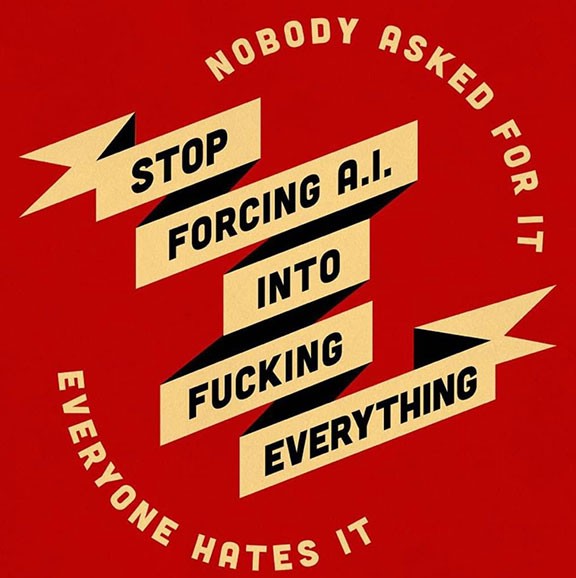Recent Posts
-
Yes, There IS a Future!
December 26, 2025
-
Real Crimes and the Coming Violence
September 6, 2025
-
Whither Modern Life?
June 27, 2025
-
What the Hell
June 18, 2025
-
As Darkness Engulfs Us
April 6, 2025
-
AI, Risk, and Work
January 17, 2025
-
“Things Are in the Saddle, and Ride Mankind”
December 29, 2024
-
Forgotten Futures in Seattle
December 12, 2024
-
Autocracy Defeats Neoliberalism
November 14, 2024
-
History… We’re Soaking in It!
October 2, 2024
|
So said Ralph Waldo Emerson in the middle of the nineteenth century. As we proceed into the glowering gloom of the coming years, I always find it helpful—if not refreshing exactly—to place things in historic context. But also to recognize that there have been deep systemic paradigm shifts again and again—and those shifts don’t come at predictable times, and don’t have predictable effects, either at their moment of eruption, or as time passes and the “new knowledge” begins to percolate through other disciplines, other epistemological frameworks.
 Sun setting in the west from Bernal Heights on Christmas Day, 2024. As usual I’ve been reading a lot, and seven books will get a quote or a mention in this post. I absolutely loved The Light Eaters: How the Unseen World of Plant Intelligence Offers a New Understanding of Life on Earth by Zoë Schlanger. Schlanger’s work contributes to a widening realization that our ideas of intelligence and communication are being radically revised. She spends a bit of time at the start of her book lamenting the role of the 1970s bestseller Secret Life of Plants for casting a long shadow over research into plant sentience and communication. That silly book took my generational cohort by storm and led actual scientists to distance themselves from any connection with such research. But Schlanger, who writes beautifully in addition to plumbing a wide variety of sources, makes it clear that a new sensibility is emerging. She visits labs where plant sentience is being researched and has the opportunity to watch as a clamp sends signals cascading throughout a plant from the spot where it is attached. She even discusses the work of Monica Gagliano, a plant scientist who showed that pea plants have the ability to follow water even in conditions of extreme isolation. Gagliano has since written about her experiments with psychedelics and insights she gained through such journeys, which has put her outside the boundaries of “real science” as maintained by those who police such borders. I wrote enthusiastically about Gagliano in a previous post “Plants are People, Too!” Here is Schlanger, helping to describe why the borders of our knowledge are in flux:
In 2012, a group of scientists gathered at the University of Cambridge to formally confer consciousness on all mammals, birds, and “many other creatures, including octopuses.” Nonhuman animals had all the physical markers of conscious states, and clearly acted with a sense of intention. “Consequently, the weight of evidence indicates that humans are not unique in possessing the neurological substrates that generate consciousness,” they declared. (p. 41)
… plants could be said to have dialects, and are alert to their contexts enough to know when to deploy them. More than that, they have a clear sense of who is who; who is family, and who is not. They are in touch with their surroundings, and with the fluctuating status of their enemies. Their communication is not just rudimentary but complex and layered, alive with multiple meanings. (p. 66)
This all the more remarkable when you think about how hard our new Know Nothing (Own Everything) political and business leaders are doubling down on the false promise of Large Language Model-based “artificial intelligence,” which is demonstrably NOT intelligent in any meaningful sense of the term. Coming from a metaphysical angle to contemplate relationships between animate and inanimate worlds, Meghan O’Gieblyn (who I originally heard on the Tech Won’t Save Us podcast) writes in her fascinating meditative work God Human Animal Machine: Technology, Metaphor, and the Search for Meaning
In the end, transhumanism and other techno-utopian ideas have served to advance what [Jaron] Lanier calls an “antihuman approach to computation,” a digital climate in which “bits are presented as if they were alive, while humans are transient fragments.” (p. 75) … But to blame the whole history of disenchantment on human egotism seemed too easy, and perhaps even at cross-purposes with what these new theoretical frameworks were trying to achieve. The discourse too often arrived at the strange conclusion that conceiving of the world, once again, as intelligent and alive would require renouncing those very qualities in ourselves. (p. 90)
Writing a few posts ago about Grove’s Savage Ecology led me to plumb his footnotes a bit and William Connolly came up a lot, apparently a mentor of sorts. He’s a prolific contemporary philosopher so it wasn’t easy to read his monograph Climate Machines, Fascist Drives, and Truth, but as a once-upon-a-time philosophy student I found my way. These same kinds of groping ruminations about where the boundaries are between different forms of intelligence, of life, of knowing, seep through his work too. In this longish quote he starts with Erasmus and ends with Sophocles (or is that Robert Johnson?):
Erasmus was impressed with what today would be called the self-organizing processes in species evolution. In such an image, the strivings of multiple intersecting entities, such as mutations, bacteria, and embryos, periodically enter into resonances with one another. Occasionally a new species emerges out of those that is irreducible to the simple replication of mutations alone. Evolution as self-organizing processes often enough includes horizontal processes exceeding the vertical processes involved in sexual relations.
Such an image of species evolution encourages less hubristic practices of science than those advanced today by proponents of climate geoengineering, cloning, nuclear physics, behavioral social science, neo-Darwinism, and—most generically—the pursuit of human mastery over a docile earth. It rather encourage scientists to watch and study life forms to gauge the multiple strivings, resonances, horizontal intersections, and bifurcation points through which evolution proceeds. A bifurcation point issues at least one if and one course actually taken. Sophocles would call it a crossroad. (p. 31)
Continue reading “Things Are in the Saddle, and Ride Mankind”
 Sunset on the Puget Sound. Had a sweet trip to Seattle for Adriana’s birthday over Thanksgiving weekend. She won some hockey tickets at a curling bonspiel so we went to see “our” San Jose Sharks beat the Seattle Kraken at the arena now known as “The Climate Pledge,” a name no one I asked could explain. I learned later that the name is a new one for an old arena built as part of the original World’s Fair in 1962—an event that crept into my 5-year-old brain even though I don’t have direct memory of it. But somehow the Space Needle and the Monorail made an early impression on me.
 The Climate Edge?  Space Needle and Monorail… The Future! in 1962… My father, who was born in 1932 in the depths of the Depression, and grew up poor in rural Connecticut, was always quite interested in World’s Fairs. He took us to the New York World’s Fair in 1964, a trip we made by passenger train from Chicago. I have a poignant 7-year-old memory of waking up at dawn on the clickety-clacking train, probably somewhere in Ohio, and sitting with my father watching the countryside flow by. I loved riding the train and later I remember the big geodesic dome at the World’s Fair, the exhibit that later went to Disneyland called “It’s a Small World” with the children’s voices singing in a big chorus “it’s a small small world… after all…” The 1964 World’s Fair also featured videophones, various corporate representations of the World of Tomorrow (General Motors, Boeing, General Electric, etc.). I’ve learned in recent years about the 1915 World’s Fair in San Francisco, and the way such fairs functioned before mass media to advertise new technologies, new ways of seeing the world, and pioneered the forms of mass-marketing and advertising that later became commonplace in large stores, and by way of radio and then television.
In Seattle they had a World’s Fair in 1962 and as it was during the Kennedy administration with its prominent push to put a “man on the moon” by the end of the decade, the space-as-future theme was central. The Space Needle remains an iconic symbol of Seattle’s skyline, but I hadn’t ever visited it until this short trip. The monorail that leaves from below the Space Needle was just as much part of the “future” that the 1962 World’s Fair was so successful at promoting. When you enter the tower today, paying a hefty $38 per person, you walk up a spiral ramp past a series of displays showing how the Space Needle “played” during its construction and opening 62 years ago.
 Welcome to the Future! 
I can’t remember watching The Jetsons, though I’m sure I did. I was born in 1957, the peak year of the baby boom, and I’ve shared with 6.4 million others countless “typical” experiences of the last half of the 20th century. Technology, fast cars, guns, American exceptionalism, teevee and the steady expansion of “major league” mass spectator sports, Hollywood and eventually computers and the internet… it’s the air I breathed alongside everyone else. But I didn’t buy it. Sure I like sports (hell, I went to Seattle to see a hockey game!), and I’ve certainly been a relatively early adopter of many of the technologies that have come along. But I’m enraged by the smug complacency that surrounds me, that thinks this is the best of all possible worlds, that feels entitled to be entertained by endless cruelty both fictional and horribly real. I supposed I’m most dismayed by the utter emptiness of the glowing futures I’ve been sold since childhood. Nobody who knows me would characterize me as believer in the American Dream—I doubt if anyone would even tar me with the shameful label of “patriot.”
 from Democracy Wall on Valencia Street in San Francisco. Continue reading Forgotten Futures in Seattle
 Golden Gate Park a few months ago… I guess it’s oddly appropriate to find myself two hours into the limbo of the jury duty room at San Francisco’s Hall of (In)justice. The clerks have ordered us to remain here several times while apologizing that the courts just aren’t ready for us. Pretty normal I suppose but more vivid evidence of the decaying civic institutions that will now creak and groan and probably crumble as a formal and popularly elected autocracy takes hold. (At the end of the day they let me go due to scheduling conflicts with the trial length.)
I didn’t vote for Harris or Trump and haven’t voted for a president since Jimmy Carter in 1976! I just don’t believe in the whole model and it feels hypocritical to pretend otherwise. My voting fits best under the rubric of “harm reduction” but I understand why so many people rejected Harris and the Democrats, especially the corporatist version they presented in this campaign (much the same as the failed 2016 Clinton campaign). Really they should be ashamed to have embraced the fuckin’ Cheneys the way they did! Dick Cheney’s endorsement should have been loudly rejected. The dude’s a war criminal and profiteer and an all around horrible human being. His daughter is not much better, albeit her hands are a bit less dirty. Still.
Neoliberalism is dead this time! Liberal democracy might be too. Trump did promise his Christian supporters that if they’d just show up and elect him that they’d never have to vote again. A lot of us have glibly assumed that the system needs the empty ritual of regular elections as a way to prove its popular support and legitimacy. Maybe, maybe not! Maybe “legitimacy” has morphed and will now be achieved by delivering the right balance of (a little) bread and (a lot of) circuses to the hungry masses. And one thing we can be sure of—Trump and his acolytes are enthusiastically planning vast Theaters of Cruelty to feed their followers’ desire for punishment, for pain infliction, for degradation, and above all, putting women and blacks “in their place.”
American culture—whether Hollywood gore-fests, or the multi-billion dollar video game industry (dominated by Pentagon-friendly products to support the “volunteer” military), or the brutal UFC ring fights, or the absurd “pro wrestling” circuit, or every Sunday NFL football, or any of a number of other attention-absorbing, money-making horrors—saturates society with endless violence. The rampant gun violence, daily TV news where “if it bleeds it leads,” and the distorted portrayal of a non-existent crime epidemic all contribute to the lonely, fearful isolation that traps ever more Americans.

Much has been made of the breakdown of a shared reality. If it’s true that door-to-door canvassing couldn’t dent the world views of people getting all their news on social media or from Fox, then indeed a mass delusional psychosis has gripped millions. Truth-telling is not an effective antidote to this unprecedented system of propaganda and mind control. Those of us who remain outside of their control are a shrinking minority—and many dissenters may face criminalization and state violence in the months and years to come. It’s a bleak picture, to be sure.
Taking bleak despair to a whole other level is Franco Berardi, aka “Bifo.” Writing now on Substack he posted his “Endgame” on November 9 (I rearranged the order of these paragraphs):
Despite being, country by country, on the brink of civil war, Western and supremacist peoples are united in the common undertaking of genocide and in the common enterprise of enforced birthing. For a long time we fooled ourselves by listening to fairy tales of a fantastic multitude ready to fight against a fantastic Empire: we didn’t have the intellectual courage to recognize social impotence, and the exhaustion of the psychic energy without which social movements are flashes in the pan.
The triumph of a man who represents in one go the racism of the Ku Klux Klan, mafia criminal profiteering, macho violence and financial absolutism is the best observation point from which to finally look retrospectively at the twentieth century, and to some extent, imagine the lines of evolution of the twenty-first. The Trump-triumph is the final proof that the workers’ movement has made a colossal mistake since the end of the nineteenth century, accepting the terrain of politics as the terrain for emancipation. Both revolutionary Bolshevism and social democratic reformism have accepted the terrain that the bourgeoisie had prepared, and on that terrain they lost all battles up to the point of being definitively erased from the panorama of social evolution. Was there another ground for social autonomy, other than political power? Of course there was: it was daily life, collective existence, which spontaneously tends to desert economic and political totalitarianism.
Workers today are isolated, psychically fragile, incapable of organization and solidarity, because the political Left exchanged autonomy for democracy, and democracy was a fake and a trap. Government based on elections could be a good idea if two conditions were met: the first is the free formation of opinion and will. The second is the effectiveness of political will in determining the lines of development of the economy and therefore of society. Both conditions have never existed in the history of the twentieth century.
Since working on Processed World back in the 1980s, I always thought the abdication of “organized labor” to the agenda(s) of capital was at the heart of the problem. I didn’t think about it in the same terms that Bifo describes above, as a rejection of the whole field of bourgeois democracy as a trap, but I think he’s right. Similar to John Holloway’s rejection of the very category of “worker” as the starting point for revolt, it’s our fundamental humanity that is the basis for our desires and ability to radically transform how we live, and to redesign how we produce life together. Because however dismayed or depressed this election might make anyone feel, the dire reality of climate chaos—spreading droughts and desertification, runaway storms and floods, collapsing agricultural production and destruction of fresh water resources—is a lot worse than the question of which person is fiddling while the planet burns.
Continue reading Autocracy Defeats Neoliberalism
|
Hidden San Francisco 2nd EDITION!

NEW 2nd EDITION NOW AVAILABLE!
Buy one here
(Pluto Press, Spring 2025)
|





















